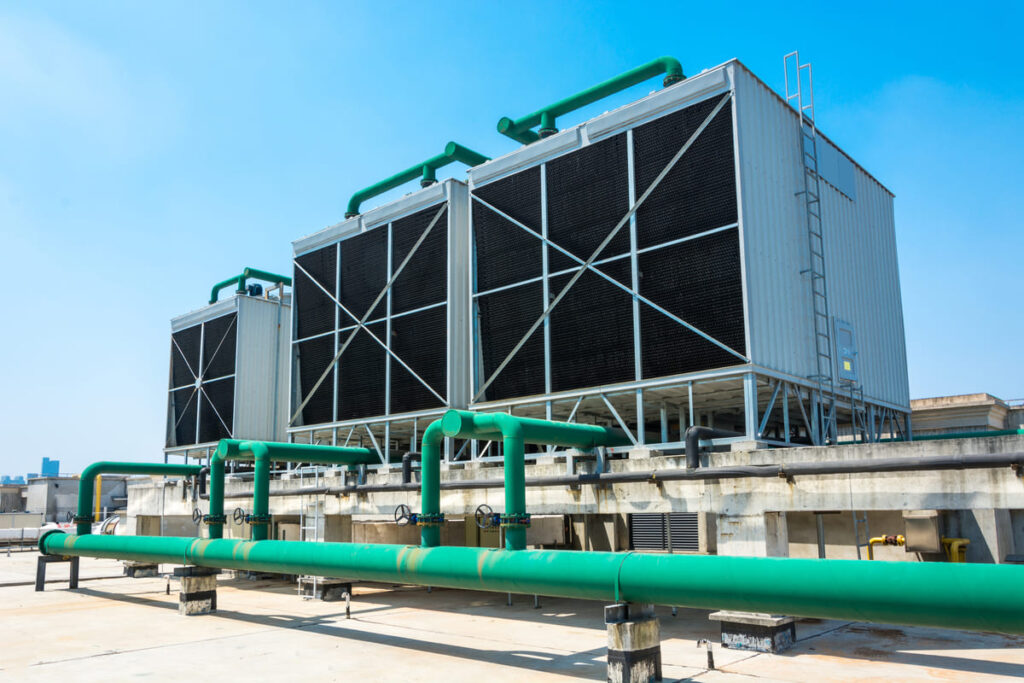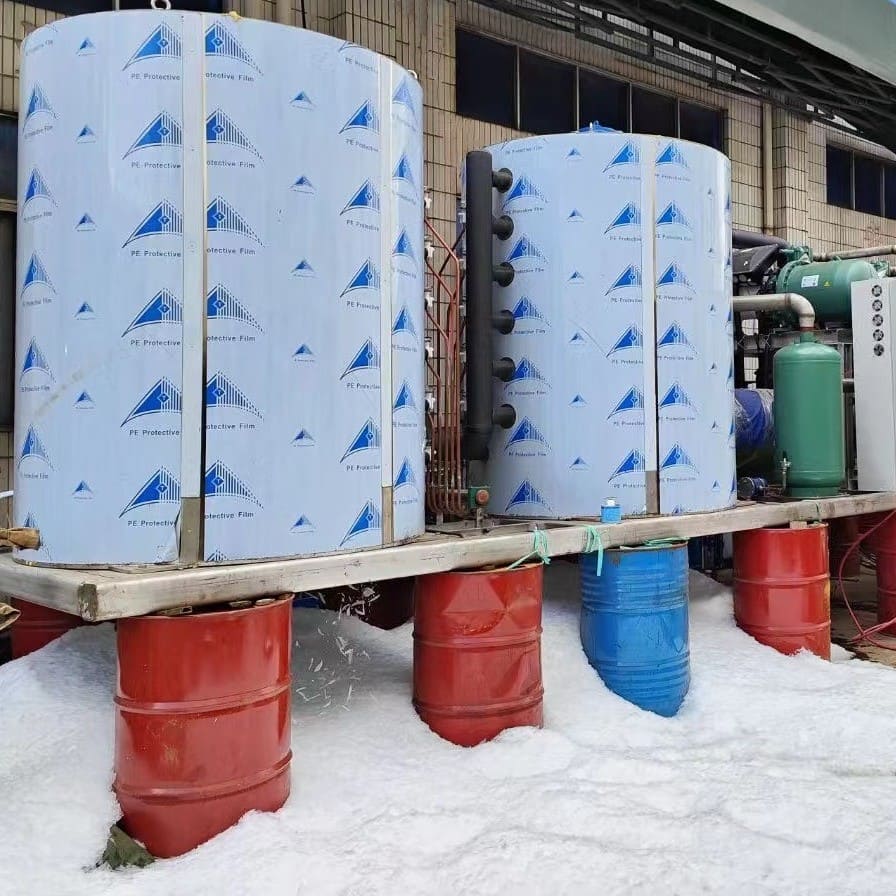Selecting the best ice machine in a concrete cooling tower system for your needs is crucial to ensuring optimal performance and efficiency. Comprehending the various elements that can affect your chosen system’s efficacy is critical for making an informed decision.
To make an informed decision on how to select the best ice machine for your concrete cooling tower system, this blog post will provide insight into various factors such as heat load calculations, approach and range measurements, wet bulb temperature, and material selection.

We will discuss key elements such as determining the ideal cooling tower size through heat load calculations, approach and range measurements, and wet bulb temperature’s role in selecting an appropriate ice machine.
Additionally, we will explore the benefits of HDPE plastic water cooling towers and material selection options like FRP material compared to other common construction materials.
Furthermore, we’ll examine different types of ice machine designs available on the market while considering factors affecting their selection such as storage capacity requirements based on application needs, physical size constraints within installation space, and technology choices.
Finally, we’ll emphasize the importance of regular maintenance and water treatment practices for maintaining peak performance over time.
Determining the Ideal Cooling Tower Size
When it comes to selecting the best ice machine for your concrete cooling tower system, size matters. The ideal size of a cooling tower should be determined by four metrics: heat load, approach, range, and wet bulb temperature. Understanding these factors will help you select the most efficient ice machine for your concrete cooling tower system to maximize its benefits.
Heat Load Calculation in a Concrete Cooling Tower System
The first step in determining the right-sized ice machine is calculating the heat load that needs to be removed from your industrial process or air conditioning application. This can be done using specific formulas based on factors such as water flow rate and temperature difference between incoming and outgoing water streams.
Importance of Approach and Range Measurements
- Approach: The difference between leaving water temperature (LWT) from the cooling tower and entering wet-bulb temperature (EWBT). A lower approach indicates higher efficiency.
- Range: The difference between hot-water return (HWR) temperature entering into a cooling tower and LWT exiting out of it. Larger ranges indicate more effective heat transfer processes within an industrial setting like those found at Hiceay’s preferred choice manufacturing facilities.
Wet Bulb Temperature’s Role in Selecting an Ice Machine
The wet bulb temperature plays a crucial role when choosing an appropriate ice machine model because it represents how efficiently evaporative coolers work under varying humidity levels present during different seasons throughout any given year – making them essential components within many types of commercial/industrial applications where maintaining optimal temperatures remains key priorities.
By understanding this factor alongside others mentioned above, you can make informed decisions about which ice machine best suits your specific needs while maximizing energy efficiency within your cooling tower system.
Determining the ideal cooling tower size is a critical step in selecting an ice machine that will best meet your needs. HDPE plastic water cooling towers offer many advantages, including their chemical resistance and durability compared to traditional materials.
To select the best ice machine for a concrete cooling tower system, it is crucial to determine the ideal size based on the heat load, approach, range, and wet bulb temperature. Calculating the heat load helps in selecting an appropriate model while understanding the approach and range measurements maximizes energy efficiency within your cooling tower system.
The wet bulb temperature plays a vital role as it represents how efficiently evaporative coolers work under varying humidity levels present during different seasons throughout any given year.
Benefits of HDPE Plastic Water Cooling Towers
HDPE plastic water cooling towers are gaining traction in many industries due to their superior ability to facilitate necessary chemical treatments. These cutting-edge materials provide a range of advantages over traditional cooling tower materials, making them an excellent option for your concrete cooling tower system.
Chemical Resistance Properties of HDPE Material
The use of chemicals is essential in maintaining optimal performance within cooling towers. However, some materials can degrade or corrode when exposed to these harsh substances. That’s where HDPE comes into play. This robust material boasts exceptional chemical resistance properties that allow it to withstand even the most aggressive treatment methods without succumbing to damage.
You’ll benefit from enhanced longevity and lower upkeep costs in comparison to other available options.
Longevity and Durability Compared to Traditional Materials
- Fiberglass: While fiberglass offers decent corrosion resistance, it can be prone to cracking and UV degradation over time.
- Metal: Metal-based systems like steel or aluminum may offer strength but often suffer from rust-related issues as well as increased energy consumption due to poor heat transfer capabilities.
- Wood: Wooden structures have been used historically; however, they’re susceptible not only to rotting but also to insect infestations, which compromise structural integrity, ultimately leading to replacement needs sooner than later.
In contrast, HDPE provides superior durability thanks to its innate flexibility combined with minimal expansion/contraction rates throughout temperature fluctuations experienced during industrial processes. This ensures your industrial cooling tower remains in tip-top shape for years to come, saving you time and money on costly repairs or replacements.
The use of HDPE plastic water cooling towers offers many benefits, including chemical resistance properties and increased longevity compared to traditional materials. By understanding the factors that affect ice machine selection, such as storage capacity requirements and physical size constraints within installation space, you can select the best option for your needs.
Factors Affecting Ice Machine Selection
When choosing an ice machine for your concrete cooling tower system, it’s essential to consider factors such as storage capacity, physical size, and the type of cooling technology used. These elements play a crucial role in ensuring optimal performance within your HVAC environment.
Storage Capacity Requirements Based on Application Needs
The first thing you need to determine is how much ice production capacity you require. This depends on the specific needs of your application – whether it’s for the fishery, seafood distribution, chilled or frozen meat import/export, or food processing plants. Make sure that the selected ice machine can meet these demands while also considering potential future growth.
Physical Size Constraints Within Installation Space
Ideally, your preferred choice should fit comfortably within the available installation space without compromising efficiency or accessibility. Be mindful of any height restrictions and ensure there is adequate clearance around the unit for proper airflow and maintenance access.
Different Types of Available Technologies
- Cooling towers: These systems use evaporative cooling principles to dissipate heat from air conditioning units and other industrial processes.
- Air-cooled machines: Self-contained units that transfer heat through vents; ideal for smaller installations with limited space constraints.
- Water-cooled machines: Utilize water rather than air to remove heat from the unit; typically more efficient but may require additional plumbing infrastructure.
- Eco-friendly options: Look out for energy-efficient models designed to minimize environmental impact by reducing power consumption and utilizing eco-friendly refrigerants like R-290 propane instead of traditional HFCs.
Ultimately, the best ice machine for your concrete cooling tower system will depend on a variety of factors. By carefully considering storage capacity requirements, physical size constraints, and available technologies, you can make an informed decision that meets your specific needs while also supporting industrial processes.
When selecting an ice machine, it is essential to weigh up all the relevant factors as they can significantly affect system performance. By examining the various designs available, you can determine which one is best suited for your particular needs.

When selecting an ice machine for your concrete cooling tower system, consider factors such as storage capacity, physical size constraints, and available technologies like cooling towers or eco-friendly options. Determine the required ice production capacity based on application needs while ensuring that the selected unit fits comfortably within the installation space without compromising efficiency or accessibility.
Types of Ice Machine Designs Available on the Market
With so many options available, selecting the perfect ice machine for your concrete cooling tower system can be quite a challenge. Let’s explore the various designs available and their respective features to aid in your decision-making process.
Water-Cooled Ice Machines for Improved Efficiency
Water-cooled ice machines use water instead of air to remove heat from the unit, making them highly efficient in industrial processes where cooling water is readily available. They are also the preferred choice when air conditioning systems struggle with high ambient temperatures or limited ventilation.
Self-Contained Air-Cooled Systems with Easy Installation
If you’re in search of a concise, straightforward installation process, self-contained air-cooled ice machines could be the ideal solution. These units transfer heat through vents and do not need additional components like remote condensers or cooling towers. However, they may consume more energy than other types due to reliance on ambient air temperature.
Remote-Condenser Units for Reduced Noise Levels
Noisy machinery can be detrimental to productivity in any workspace. To combat this issue, opt for remote-condenser ice machines, which separate the noisy condensing unit from the main body of the machine – reducing noise levels significantly while maintaining optimal performance.
Evaporative Coolers Offering Low-Maintenance Solutions
- Ease of maintenance: Evaporative cooling towers require minimal upkeep, making them an attractive option for busy industrial settings.
- Contact surface area: These coolers provide a large contact surface between water and air, ensuring efficient heat transfer and reducing the need for additional equipment like pumps or fans.
Incorporating these factors into your decision-making process will help you choose the best ice machine design to suit your concrete cooling tower system’s unique requirements. Don’t forget to also consider other aspects such as material selection and regular maintenance practices.
The selection of the right type of ice machine for a concrete cooling tower system depends on various factors, such as efficiency and noise levels. Consequently, it is essential to evaluate all the choices prior to settling on a choice. Moving forward, let us take a look at the material selection for these systems and explore which materials are best suited for this purpose.
Selecting the perfect ice machine for your concrete cooling tower system can be challenging, but understanding the different types of designs available on the market can help. Water-cooled ice machines are highly efficient in industrial processes, self-contained air-cooled systems offer easy installation, remote-condenser units reduce noise levels and evaporative coolers provide low-maintenance solutions with large contact surface area between water and air.
Material Selection for Concrete Cooling Tower Systems
If you want your concrete cooling tower system to stand the test of time, choosing the right material is crucial. The preferred choice among industry professionals is a fiberglass-reinforced polymer (FRP) due to its resistance against moisture-related decay compared to wood, steel, or aluminum materials which can warp or rot over time.
Advantages of using FRP material in cooling towers
Fiberglass-reinforced polymer (FRP) offers several benefits that make it an ideal choice for constructing cooling towers. FRP’s corrosion resistance makes it able to withstand water and chemical exposure, ensuring a structure that is long-lasting and requires minimal upkeep. This results in a longer-lasting structure with minimal maintenance requirements.
- Durability: FRP has an impressive strength-to-weight ratio, making it able to endure extreme conditions without compromising structural integrity.
- Mold Resistance: Unlike wood or metal alternatives, FRP does not support mold growth – keeping your air conditioning system free from harmful contaminants.
- Ease of Installation: Lightweight yet sturdy, FRP components are easy to transport and assemble on-site – saving both time and labor costs during construction projects.
Comparing FRP with other common construction materials
In comparison with traditional building materials like wood, steel, or aluminum – all three susceptible candidates when it comes to their vulnerability towards moisture damage; none hold up quite as well under these circumstances as our champion contender here today:
By selecting the right material for your concrete cooling tower system, you can ensure a long-lasting and efficient operation. Regular maintenance and water treatment are also essential to maintain the optimal performance of any ice machine in a concrete cooling tower system.
Importance of Regular Maintenance and Water Treatment
In addition to material considerations when selecting an appropriate ice machine for your needs within a concrete HVAC environment, regular maintenance practices must be employed alongside well-treated water sources. This not only extends product life but also minimizes the possible proliferation and diffusion of organic substances throughout operation periods.
Routine Inspection and Cleaning Procedures
To ensure optimal performance from your cooling tower system, it’s essential to perform routine inspections and cleaning procedures. These include checking for debris in the cooling tower basin, inspecting belts and pulleys for wear or damage, monitoring fan motor bearings, lubricating moving parts as needed, and cleaning strainers regularly.
By staying on top of these tasks, you can prevent costly downtime due to equipment failure or inefficiencies caused by poor maintenance.
Proper Chemical Treatment for Water Quality Management
Maintaining high-quality water is crucial in any cooling tower system. Proper chemical treatment helps control scale formation, corrosion rates, and biological growths like algae or bacteria that could harm your industrial processes. To achieve this balance:
- Monitor pH levels: A neutral pH range (7-9) ensures effective corrosion inhibition while minimizing scaling potential.
- Biofilm control: Use biocides to eliminate harmful microorganisms that may cause fouling issues within the cooling water circuitry.
- Filtration systems: Install filters capable of removing suspended solids that contribute towards sediment buildup inside heat exchangers/condensers over time – ultimately reducing overall efficiency.
Taking care of your cooling tower system with regular maintenance and proper water treatment will not only extend the life of your equipment but also ensure that it operates at peak efficiency. Remember, a well-maintained ice machine is the preferred choice to keep your cooling tower running smoothly for industrial processes.
FAQs in Relation to How to Select the Best Ice Machine in a Concrete Cooling tower System for Your Needs
What Factors to Consider Before Choosing a Cooling Tower?
Before selecting a cooling tower, consider the heat load requirements, approach and range values, wet bulb temperature, material selection (e.g., FRP), available space within your facility layout, required storage capacity based on demand, and desired type of cooling technology such as water-cooled or air-cooled systems.
How to Choose a Cooling Tower Pump?
To choose an appropriate cooling tower pump, evaluate flow rate requirements for optimal system performance (affinity laws can help), head pressure needed to overcome friction losses in piping and components, pump efficiency ratings at various operating points (check manufacturer’s curves), compatibility with existing infrastructure and materials used in the system.
How to Determine the Cooling Effectiveness of the Cooling Tower?
Cooling effectiveness is determined by comparing the inlet hot water temperature with the outlet cold water temperature. Calculate it using this formula: Effectiveness = (Hot Water Temperature – Cold Water Temperature) / (Hot Water Temperature – Wet Bulb Temperature). Higher values indicate better cooling performance.
What Is the Most Efficient Type of Cooling Tower?
The most efficient type depends on specific application needs. However, evaporative condensers tend to be more energy-efficient than other types due to their ability to reject heat through evaporation while consuming less power. Factors such as local climate, water availability, and space constraints also influence the selection of an efficient cooling tower.
Conclusion
In conclusion, selecting the best ice machine for your concrete cooling tower system requires careful consideration of factors such as heat load calculation, approach, range considerations, wet bulb temperature, physical size constraints, and storage capacity requirements. Additionally, choosing the right material for your cooling tower system and implementing regular maintenance and water treatment are crucial to ensuring optimal performance and longevity.
At Hiceay, we offer a wide selection of high-quality ice machines that can be customized to meet your specific needs. Whether you’re in the fishery industry or food processing plant business, our team is here to help you find the perfect solution. Contact us today at hiceay.com to learn more!


